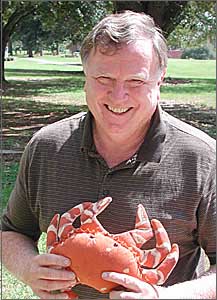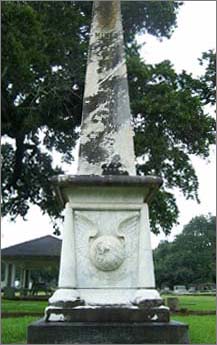Jack O'Brien's Research Area
My research interests are ecological parasitology; biology of parasitic castrators especially rhizocephalan barnacles; diversity of parasites within the Mobile-Tensaw Delta of Alabama and Ubatuba Bay in Brazil; crustacean biology; and the construction of submarines such as the H.L. Hunley in Mobile during the Civil War.
My research projects are:
1. Investigating chemical cues used by rhizocephalan barnacles to detect vulnerable hosts.
2. Determining environmental parameters that affect where and when in Mobile Bay that blue crabs are parasitized by the infective stage of the rhizocephalan, Loxothylacus texanus.
3. Surveying the diversity and prevalence of parasites in fish, amphibian, and reptile hosts in the Mobile-Tensaw Delta and Mobile Bay.
4. Documenting the technological contributions made by citizens of Mobile during the Civil War that demonstrated the feasibility of underwater warfare as exemplified by the construction of true submarines such as the H.L. Hunley
Selected Publications
- T. D. Sherman, E. Boone, A. B. Morris, A. Woodard*, E. Goldman*, D. L. Martin, C. Gautier*, and J. J. O’Brien (2008) Investigations of internal interactions between the parasitic barnacle Loxothylacus texanus(Rhizocephala: Sacculinidae) and its host Callinectes sapidus (Brachyura: Portunidae) using PCR techniques. J. Crustacean Biology 28(2): 220-227
- Boone, E., A.A. Boettcher, T.D. Sherman, and J.J. O'Brien, 2004, What constrains the geographic and host range of the rhizocephalan, Loxothylacus texanus, in the wild? Journal of Experimental Marine Biology and Ecology. 309: 129-139.
- Tindle, S., E. Boone, J.J. O'Brien, and A.A. Boettcher, 2004, Effects of salinity on larval stages of the rhizocephalan barnacle, Loxothylacus texanus, Journal of Experimental Marine Biology and Ecology 302:165-176.
- Boone, E., A.A. Boettcher, T.D. Sherman, and J.J. O'Brien, 2003, Characterization of settlement cues used by the rhizocephalan barnacle Loxothylacus texanus., Marine Ecology Progress Series 252: 187-197
- Mantelatto, Fernando L., Jack J. O'Brien, and Renata Biagi, 2003, Parasites and Symbionts of Crabs from Ubatuba Bay, Sao Paulo State, Brazil, Comparative Parasitology, 70(2): 211-214.
- Alvarez, F., E. Campos, J.T. Hoeg, and J.J. O'Brien, 2001, Distribution and prevalence records of two parasitic barnacles (Crustacea: Cirripedia: Rhizocephala) from the west coast of North America, Bulletin of Marine Science 68(2): 233-241.
- Glenner, H., J.T. Hoeg, J.J. O'Brien, T.D. Sherman, 2000, Invasive vermigon stage in the parasitic barnacles, Loxothylacus texanus and L. panopaei (Sacculinidae): Closing of the rhizocephalan life-cycle. Marine Biology 224: 249-257.
- O'Brien, J.J. and D.M. Skinner, 1990, Overriding of the molt-inducing stimulus of multiple limb autotomy in the mud crab, Rhithropanopeus harrisii, by parasitization with a rhizocephalan, Journal of Crustacean Biology 10: 440-445.
Current Graduate Students:
Jason Herrmann, Chemical cues used by the parasitic barnacle, Loxothylacus texanus, to detect susceptible hosts. (Co-chair with A. Boettcher)
Current Undergraduate Students:
Amanda Church, Survey of parasites and symbionts endemic to Mobile and Baldwin Counties, Alabama
Caroline Raghed, Interactions between the host grass shrimp, Palaemonetes pugio and the gill parasite,Probopyrus pandalicola
Previous Graduate Students:
Emily Golden, Detection of infection by a rhizocephalan barnacle by PCR (co-sponsor with A Boettcher & T. Sherman)
Kate Sheehan, Proteins of metacercial cysts parasitizing the grass shrimp, Palaemonetes pugio
Christy Gautier, 2003, The settlement and prevalence of the rhizocephalan barnacle, Loxothylacus texanus, on its crab host, Callinectes sapidus (University and departmental honors).
Pam Gray, 2003, Effect of dissolved sugars on settlement of Loxothylacus larvae.
Holly Mann, 2003, Interactions between the microphallid trematode, Microphallus turgidus, its second intermediate host, Palaemonetes pugio, and predatory fish of the genus Fundulus.
Stephen Tindle, 2000, The effects of salinity on larval development and settlement of the rhizocephalan barnacle, Loxothylacus texanus.
Jennifer Kearley, 1999, Use of substrate gels to analyze the effect of extracts from the ecdysial membrane on proteinases from the exoskeleton of the blue crab.
Leslie Lassiter, 1998, Settlement of post-larval crabs in Mississippi Sound.
Alisha Ashurst, 1997, Selective binding of Schistosoma mansoni cercariae to Biomphalaria proteins.
Ed Hed, 1997, Phototactic behavior of Loxothylacus texanus larvae.
Andrew Wookard, 1997, The use of polymerase chain reaction as a tool to determine the presence of
Loxothylacus texanus in Callinectes sapidus.
Adriane Cej, 1996, Phototactic responses of larval stages of the parasitic barnacle, Loxothylacus texanus.

Assistant Professor
B.A. Biology, Stanford University
Ph.D. Biology, University of California at Santa Barbara
Research Interests: Ecological parasitology; biology of parasitic castrators especially rhizocephalan barnacles; diversity of parasites within the Mobile-Tensaw Delta of Alabama and Ubatuba Bay in Brazil; crustacean biology; development of underwater technology and the building of submarines such as the H.L. Hunley in Mobile during the Civil War.
Office: LSCB 52
Phone: (251) 460-7525
Email: jobrien@southalabama.edu
Personal Interests
I am fascinated in the development of underwater technology and the building of submarines such as the H.L. Hunley in Mobile during the Civil War. In this regard I would love to share some really interesting information with you.

THE SEAMAN'S BETHEL CHURCH
The Seaman’s Bethel Church is now located on the campus of the University of South
Alabama. Although there is a conflicting account, two contemporary eyewitnesses stated
that this church was the assembly site of the Confederate submarine H.L. Hunley,that on February 17, 1864 detonated an explosive device under the hull of the U.S.S. Housatonic in Charleston Harbor to become the first submarine to sink an enemy ship in combat.

Michael Hines (1822-1864) was a blacksmith, a city alderman, a foundry owner, and he served for 18 years as the foreman of the Torrent Volunteer Fire Company (Company #5). He was born in France and may have been the “Frenchman” who purportedly attempted an unsuccessful attack on the Union blockading fleet in a submarine of his own invention.
(See Official Records of the Union and Confederate Navies in the War of the Rebellion, Series I, vol XIX, p. 628)


